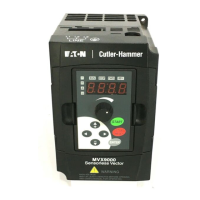Motor Operation Precautions
3-10 MVX9000 User Manual
Storage and
Installation
Figure 3-6: Parallel Grounding
• When the AC drive output terminals U/T1, V/T2 and W/T3 are connected to
the motor terminals T1, T2 and T3, respectively, the motor will rotate
counterclockwise (as viewed from the shaft ends of the motor) when a
forward operation command is received. To reverse the direction of motor
rotation, switch over any of the two motor leads.
• Make sure that the power source is capable of supplying the correct voltage
and required current to the AC drive.
• Do not attach or remove wiring when power is applied to the AC drive.
• Do not inspect components unless the inside “POWER” lamp has turned off.
• Do not monitor the signals on the circuit board while the AC drive is in
operation.
• For the single-phase rated AC drives, the AC power can be connected to any
two of the three input terminals R/L1, S/L2, T/L3. Note: This drive is not
intended for use with single-phase motors.
• Route the power and control wires separately, or at a 90 degree angle to each
other.
• If a filter is required for reducing EMI (Electro Magnetic Interference), install it
as close as possible to the AC drive. EMI can also be reduced by lowering the
Carrier Frequency.
• If the AC drive is installed in the place where a load reactor is needed, install
the filter close to U/T1, V/T2, W/T3 side of AC drive. Do not use a Capacitor or
L-C Filter (Inductance-Capacitance) or R-C Filter (Resistance-Capacitance),
unless approved by Eaton.
• When using a GFCI (Ground Fault Circuit Interrupt), select a current sensor
with sensitivity of 200 mA, and not less than 0.1-second detection to avoid
nuisance tripping.
Motor Operation Precautions
• When using the AC drive to operate a standard 3-phase induction motor,
notice that the energy loss is greater than for an inverter duty motor.
• Avoid running a standard induction motor at low speed. Under these
conditions, the motor temperature may rise above the motor rating due to
limited airflow produced by the motor’s fan.
• When the standard motor operates at low speed, the output load must be
decreased.
• If 100% output torque is desired at low speed, it may be necessary to use a
special “inverter-duty” rated motor.
Yes Yes No
Forward
Running

